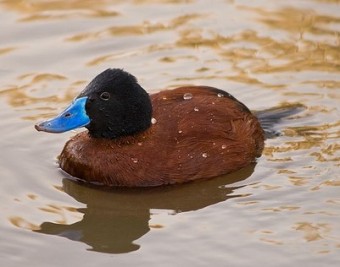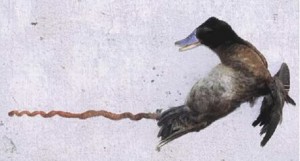There is a Type of Duck That Sometimes Lassos its Potential Mates with its Penis
 Today I found out that there is a type of duck that sometimes lassos potential mates with its penis to prevent them from getting away.
Today I found out that there is a type of duck that sometimes lassos potential mates with its penis to prevent them from getting away.
Most male birds do not have penises. They typically copulate by briefly touching genital openings with a female, called a “cloacal kiss”. However, most ducks do have penises. The theory behind why this is the case being that, because they are aquatic birds, it is likely that most of the sperm would be washed away after a cloacal kiss.
Chief among ducks, in terms of phallic prowess, is the Argentine Lack Duck (Oxyura vittata), who not only has a penis, but has a penis as long as the duck himself! Not only would this lucky duck get to redefine the game of “just the tip”, but the way it seduces unsuspecting females would make even Ron Jeremy jealous.
Researchers at the University of Alaska theorize that the duck uses its penile advantage to lasso escaping females, in an attempt to mate with them. In their own words: “Our best guess is that the birds use [the long penis] as a kind of lasso… The males have to chase the females, and even during copulation the females are trying to escape.”
The Argentine lake duck is small, weighing a little more than a pound (640 grams) and around 16 inches (41 centimeters) long from head to tail. It’s a stiff-tail duck and, like many species in the stiff-tail duck family, they have rather long penises compared to their body size. Most of these birds, however, rival human length at approximately 6-8 inches (if you’re lucky!). The Argentine lake duck appears to be an overachiever and can have penises up to 17 inches long, giving them the largest penises of any known bird.
There is very little pair-bonding between the males and females in this species and the female ducks are often resistant to mating. Because of this, the courtship displays to attract females are elaborate, vigorous, and typically performed in the presence of other ducks. Researchers don’t discount the idea that sexual selection (the idea that the females prefer a longer penis) has played a role in the development of the Argentine duck’s very long member. They think it is more likely, though, to be the result of limited access to females, and intense sperm competition.
 The penis itself is covered with coarse spines, while the tip is soft and brush-like. The researchers think the duck may use the brush-like tip as a sort of cleansing instrument before ejaculation to remove sperm in the female’s oviduct that was deposited by another suitor, thus increasing the mating ducks chances of paternity. Whatever the reason for the brusk-like tip, it’s clear that the term french tickler should now perhaps be renamed to the Argentine tickler!
The penis itself is covered with coarse spines, while the tip is soft and brush-like. The researchers think the duck may use the brush-like tip as a sort of cleansing instrument before ejaculation to remove sperm in the female’s oviduct that was deposited by another suitor, thus increasing the mating ducks chances of paternity. Whatever the reason for the brusk-like tip, it’s clear that the term french tickler should now perhaps be renamed to the Argentine tickler!
Bonus Facts:
- Initially, it was thought that the Argentine Lake Duck’s penis was only about 8 inches long. This was due to the fact that measurements were taken after dissecting the ducks. It wasn’t until recently that these ducks were observed in the wild and their fully erect penises were observed to be sometimes longer than the duck itself or around twice the previously thought length.
- When not corkscrewing out of the duck, the penis retracts fully into the duck’s abdomen.
- Female ducks have similarly corkscrew shaped “vaginas”, called oviducts. It is thought that this is a further defense mechanism against being impregnated by male ducks that they have not chosen to be impregnated by, with the complex oviduct serving to impede the sperm from reaching their goal.
- It is estimated that about 1 in 3 duck mating acts are rape, with the female struggling to get away, even during copulation. Interestingly, in around 90% of these rape cases, the female will not get pregnant thanks to the complexities in their oviduct.
- It also not uncommon that several males will gang up on a female duck to rape her, occasionally resulting in the death of the female and more often resulting in her injury.
- The largest animal penis ever measured was 2.4 m flaccid (8 feet). It belongs to the blue whale.
- Male barnacles have the largest penis proportional to its body size in the animal kingdom. It can reach up to 50 times the length of the barnacles’ body. It reaches out of the shell and transfers its sperm to a female neighbor. After fertilization, the female barnacle broods its eggs until they hatch as a minute nauplius larva which swims until it transforms to another larval stage called a cypris that then settles head-down on a suitable surface.
- The world’s longest sperm actually belongs to a tiny fruit fly called Drosophila bifurca. When the coiled sperm is straightened out, it measures about 2 inches. That is over 1,000 times longer than a human sperm. The testes of a fruit fly makes up 11 percent of the body mass of the male.
- At 188 decibels, the whistle of the blue whale is among the loudest sounds produced by any animal.
- Blue whale calves are among the planet’s largest creatures. After about a year inside its mother’s womb, a baby blue whale emerges weighing up to 3 tons and about 25 feet long. It gorges on nothing but mother’s milk and gains about 200 pounds every day for its first year.
- A male giraffe will perform a procedure known as the “fleshmen sequence” to see if the female is in heat. First, he nudges her rump to induce urination. He then takes a mouthful of urine. If it tastes like she is in estrus, then he begins to court her. Once a male decides to court a female, he follows her determinedly over a period of hours or even days in order to mate with her.
- Female giraffes give birth standing up. Their young endure a rather rude welcome into the world by falling more than 5 feet to the ground at birth. These infants can stand in half an hour and run with their mothers an incredible ten hours after birth.
| Share the Knowledge! |
|





Well, that’s one daffy duck dick, Doc!
@richard: You beat me to it with your “da-du-di-Doc” comment! I love playing with words when it results in comments like yours! Thanks…
It’s actually known as the flehmen sequence, not sequence
“Fleshmen” should be “flehmen”. This is not unique to giraffes, but is common to most ungulates.
Gross
“Theorize”….as the kids say “pictures or it didn’t happen”.